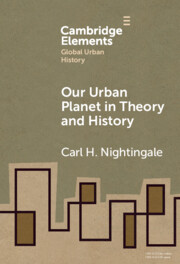11 results
3 - Righteous Guys
- from Scene I - Hieronymus Sebastian Schutze and Hans Devil
-
- Book:
- The War People
- Published online:
- 19 December 2024
- Print publication:
- 19 December 2024, pp 41-57
-
- Chapter
- Export citation
1 - Introduction
-
- Book:
- World Cities in History
- Published online:
- 12 December 2024
- Print publication:
- 19 December 2024, pp 1-21
-
- Chapter
- Export citation

Our Urban Planet in Theory and History
-
- Published online:
- 14 May 2024
- Print publication:
- 06 June 2024
-
- Element
- Export citation
3 - The Problem of Platform Knowledge
-
- Book:
- The Networked Leviathan
- Published online:
- 20 July 2023
- Print publication:
- 03 August 2023, pp 80-108
-
- Chapter
-
- You have access
- Open access
- HTML
- Export citation
Blagoustroistvo: Infrastructure, Determinism, (Re-)coloniality, and Social Engineering in Moscow, 1917–2022
-
- Journal:
- Comparative Studies in Society and History / Volume 65 / Issue 3 / July 2023
- Published online by Cambridge University Press:
- 20 April 2023, pp. 587-615
-
- Article
-
- You have access
- Open access
- HTML
- Export citation
5 - “In a Forest of Humans”:
- from Part II - Militarized Cartographies
-
-
- Book:
- Global 1979
- Published online:
- 01 July 2021
- Print publication:
- 15 July 2021, pp 141-177
-
- Chapter
- Export citation
Chapter 8 - Urban Studies
- from Part II - Recent Critical Methods Applied to Stevens
-
-
- Book:
- The New Wallace Stevens Studies
- Published online:
- 18 June 2021
- Print publication:
- 08 July 2021, pp 111-122
-
- Chapter
- Export citation
The challenges of China–India comparative urban studies
-
- Journal:
- International Journal of Asian Studies / Volume 19 / Issue 2 / July 2022
- Published online by Cambridge University Press:
- 14 May 2021, pp. 319-332
-
- Article
- Export citation
THE ḤAWĀKĪR OF NAZARETH: THE HISTORY AND CONTEMPORARY FACE OF A CULTURAL ECOLOGICAL INSTITUTION
-
- Journal:
- International Journal of Middle East Studies / Volume 50 / Issue 3 / August 2018
- Published online by Cambridge University Press:
- 05 September 2018, pp. 537-556
- Print publication:
- August 2018
-
- Article
- Export citation
SF, Infrastructure, and the Anthropocene: Reading Moxyland and Zoo City
-
- Journal:
- Cambridge Journal of Postcolonial Literary Inquiry / Volume 3 / Issue 3 / September 2016
- Published online by Cambridge University Press:
- 21 October 2016, pp. 345-359
-
- Article
- Export citation
German Jews in Paris: Traversing Modernity
-
- Journal:
- Cambridge Journal of Postcolonial Literary Inquiry / Volume 3 / Issue 1 / January 2016
- Published online by Cambridge University Press:
- 16 December 2015, pp. 79-95
-
- Article
- Export citation

